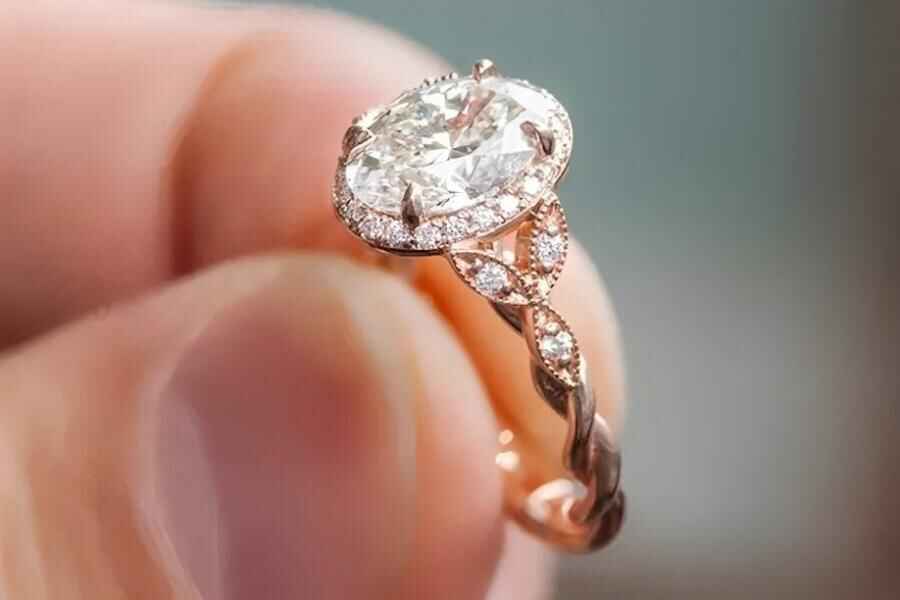Identification of natural Diamonds and its Simulants. Natural diamonds, either as loose gemstones or mounted in Jewellery, can be distinguished from their simulants in the following ways:
Table of Contents
1): natural diamonds Examination by hand lens
A diamond specialist should be able to recognize diamonds by using only an eyeglass. By using this, one can observe the

a) Inclusions
b)Fire
c)Luster
d)Facet condition (related to hardness)
a) Inclusions
In diamond crystals, feathers, natural and other typical diamond inclusion can be seen. Such types of inclusions are not present in the simulants.
Titanates and CZ are usually free from inclusions. Some tiny bubbles may be seen. While gas bubbles are never seen in diamonds.
This is not to say that a stone free from typical diamond characteristics is not a diamond. It may be a rare Loupe clean diamond.
b) Fire
Titanate, CZ, and Rutile exhibit more fire. While many simulants like YAG, spinal, and Sapphire have very less fire.
c) Luster
It is surface refraction and it’s highest in a diamond. Diamond’s luster is called adamantine. Only CZ comes anywhere near diamond in this respect.
d) Facet condition
Diamond is the hardest gem material. The facet edges of a cut diamond remain sharp with little if any damage from abrasion, even after many years of normal use. Most of the simulants, being softer than diamond, will show rounded & abraded facet edges and scratches on the facet after a few years of wear.
The presence of abraded facet edges is not, therefore, conclusive proof that the stone is simulant.
- By Specific Gravity
S.G. of a loose diamond is 3.52. Most of the simulants have higher S.G. So by determining the S.G. one can separate Diamond from its simulants. This test can be done over rough & polished both.
3. Thermal Conductivity
Diamonds are very good conductors of heat. Diamond simulants have a relatively very poor ability to conduct heat.
Such thermal conductivity meters can be used on rough or cut, on loose or mounted stones, even if they are very small in size.
- Refractive index & Reflectivity
Those simulants having R.I. less than 1.81 may be identified using a standard refractometer. But for Diamonds and simulants (having RI more than 1.81) Reflectivity meters are used. This type of meter is limited in use as the methods are only reliable with stones that have a fine degree of polish, are thoroughly clean, and are of reasonable size (over 0.10ct.).
- Fluorescence & Spectrum
Most of Diamond’s fluorescence is blue when excited by long-wave UV radiations. The degree of fluorescence varies from Diamond to Diamond. When testing a piece of jewellery studded with diamonds, a number of diamonds would not be expected to fluoresce with the same degree of intensity. This uneven intensity of fluorescence of the stone may indicate diamonds.
Cape series diamonds show very strong absorption at 415 nm. It also shows weak absorptions at 423, 435, 452, 465, and 478 nm.
Some brown diamonds have lines at 495, 512, and 537 nm.
On the other hand, diamond simulants do not have any characteristic spectrum.
- X-rays
Diamonds are highly transparent to x-rays. While most of the simulants absorb the x-rays. Due to this, they are opaque for x-rays.
Diamond simulants are materials that resemble diamonds but have different chemical and physical properties. They are often used as alternatives to natural diamonds in jewelry and other applications due to their lower cost. Here are some common diamond simulants:
- Cubic Zirconia (CZ): Cubic zirconia is a popular diamond simulant. It is a synthetic crystal that is hard and usually colorless, resembling a diamond’s appearance. CZ is optically flawless, but it is softer than a diamond, making it more prone to scratches and abrasions over time.
- Moissanite: Moissanite is a naturally occurring mineral, silicon carbide, which is often synthesized for use in jewelry. It has a similar appearance to a diamond but has different optical properties. Moissanite is doubly refractive, meaning it displays double the facets when compared to a diamond. It is also very durable and nearly as hard as a diamond.
- White Sapphire: White sapphire is a colorless variety of the mineral corundum, which is the same mineral family as rubies and sapphires. While it is a hard gemstone, it lacks the brilliance and fire of a diamond, making it distinguishable to a trained eye.
- White Topaz: White topaz is a naturally occurring gemstone that is often used as a diamond simulant. It is relatively hard but lacks the sparkle and fire of a diamond. It is also less expensive than many other diamond simulants.
- Synthetic Diamonds: These are lab-grown diamonds that have the same chemical composition and physical properties as natural diamonds. They are not simulants but are included here because they are often used as affordable alternatives to mined diamonds. Synthetic diamonds are virtually identical to natural diamonds, and in many cases, advanced testing equipment is needed to differentiate between them.
- Glass: Though not common in high-quality jewelry, glass can be used as a cheap diamond simulant. It is much softer than a diamond and lacks the brilliance and durability of real diamonds.
When purchasing jewelry, it’s essential to be aware of the differences between natural diamonds and their simulants to make an informed decision. Certified gemologists can help distinguish between these materials using specialized tools and techniques.
know more about diamond simulants, please visit international institute of gemology’s article .
if you wish buy diamonds direct from manufacturers please visit our online store.



